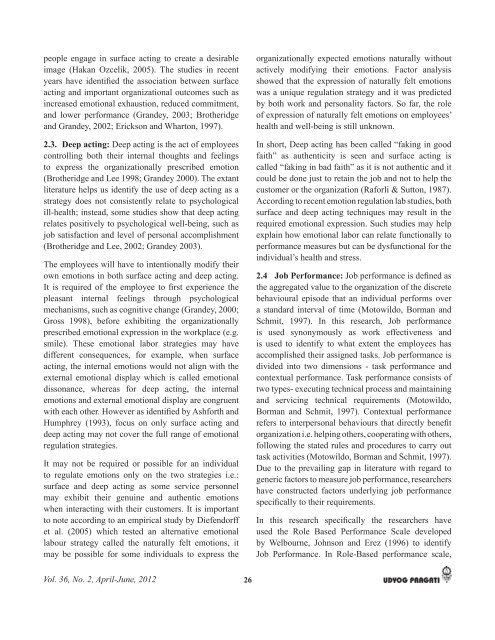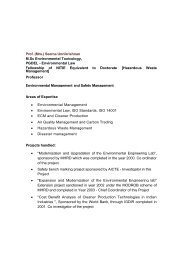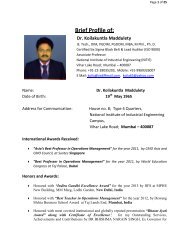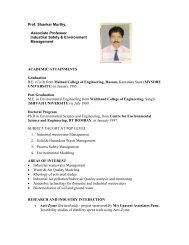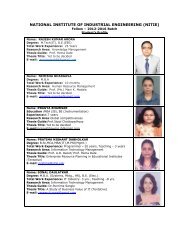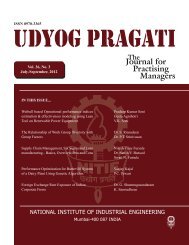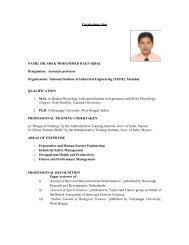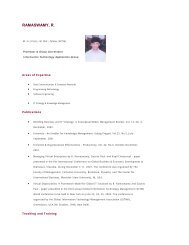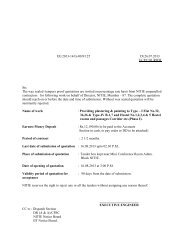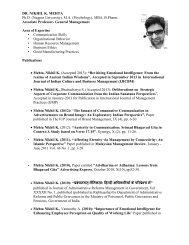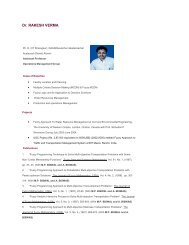Apr-Jun.12 - the Nitie
Apr-Jun.12 - the Nitie
Apr-Jun.12 - the Nitie
Create successful ePaper yourself
Turn your PDF publications into a flip-book with our unique Google optimized e-Paper software.
people engage in surface acting to create a desirable<br />
image (Hakan Ozcelik, 2005). The studies in recent<br />
<br />
acting and important organizational outcomes such as<br />
increased emotional exhaustion, reduced commitment,<br />
and lower performance (Grandey, 2003; Bro<strong>the</strong>ridge<br />
and Grandey, 2002; Erickson and Wharton, 1997).<br />
Deep acting is <strong>the</strong> act of employees<br />
controlling both <strong>the</strong>ir internal thoughts and feelings<br />
to express <strong>the</strong> organizationally prescribed emotion<br />
(Bro<strong>the</strong>ridge and Lee 1998; Grandey 2000). The extant<br />
literature helps us identify <strong>the</strong> use of deep acting as a<br />
strategy does not consistently relate to psychological<br />
ill-health; instead, some studies show that deep acting<br />
relates positively to psychological well-being, such as<br />
job satisfaction and level of personal accomplishment<br />
(Bro<strong>the</strong>ridge and Lee, 2002; Grandey 2003).<br />
The employees will have to intentionally modify <strong>the</strong>ir<br />
own emotions in both surface acting and deep acting.<br />
<br />
pleasant internal feelings through psychological<br />
mechanisms, such as cognitive change (Grandey, 2000;<br />
Gross 1998), before exhibiting <strong>the</strong> organizationally<br />
prescribed emotional expression in <strong>the</strong> workplace (e.g.<br />
smile). These emotional labor strategies may have<br />
different consequences, for example, when surface<br />
acting, <strong>the</strong> internal emotions would not align with <strong>the</strong><br />
external emotional display which is called emotional<br />
dissonance, whereas for deep acting, <strong>the</strong> internal<br />
emotions and external emotional display are congruent<br />
<br />
Humphrey (1993), focus on only surface acting and<br />
deep acting may not cover <strong>the</strong> full range of emotional<br />
regulation strategies.<br />
It may not be required or possible for an individual<br />
to regulate emotions only on <strong>the</strong> two strategies i.e.:<br />
surface and deep acting as some service personnel<br />
may exhibit <strong>the</strong>ir genuine and au<strong>the</strong>ntic emotions<br />
when interacting with <strong>the</strong>ir customers. It is important<br />
to note according to an empirical study by Diefendorff<br />
et al. (2005) which tested an alternative emotional<br />
labour strategy called <strong>the</strong> naturally felt emotions, it<br />
may be possible for some individuals to express <strong>the</strong><br />
organizationally expected emotions naturally without<br />
actively modifying <strong>the</strong>ir emotions. Factor analysis<br />
showed that <strong>the</strong> expression of naturally felt emotions<br />
was a unique regulation strategy and it was predicted<br />
by both work and personality factors. So far, <strong>the</strong> role<br />
of expression of naturally felt emotions on employees’<br />
health and well-being is still unknown.<br />
In short, Deep acting has been called “faking in good<br />
faith” as au<strong>the</strong>nticity is seen and surface acting is<br />
called “faking in bad faith” as it is not au<strong>the</strong>ntic and it<br />
could be done just to retain <strong>the</strong> job and not to help <strong>the</strong><br />
customer or <strong>the</strong> organization (Raforli & Sutton, 1987).<br />
According to recent emotion regulation lab studies, both<br />
surface and deep acting techniques may result in <strong>the</strong><br />
required emotional expression. Such studies may help<br />
explain how emotional labor can relate functionally to<br />
performance measures but can be dysfunctional for <strong>the</strong><br />
individual’s health and stress.<br />
<br />
<strong>the</strong> aggregated value to <strong>the</strong> organization of <strong>the</strong> discrete<br />
behavioural episode that an individual performs over<br />
a standard interval of time (Motowildo, Borman and<br />
Schmit, 1997). In this research, Job performance<br />
is used synonymously as work effectiveness and<br />
is used to identify to what extent <strong>the</strong> employees has<br />
accomplished <strong>the</strong>ir assigned tasks. Job performance is<br />
divided into two dimensions - task performance and<br />
contextual performance. Task performance consists of<br />
two types- executing technical process and maintaining<br />
and servicing technical requirements (Motowildo,<br />
Borman and Schmit, 1997). Contextual performance<br />
<br />
organization i.e. helping o<strong>the</strong>rs, cooperating with o<strong>the</strong>rs,<br />
following <strong>the</strong> stated rules and procedures to carry out<br />
task activities (Motowildo, Borman and Schmit, 1997).<br />
Due to <strong>the</strong> prevailing gap in literature with regard to<br />
generic factors to measure job performance, researchers<br />
have constructed factors underlying job performance<br />
<br />
<br />
used <strong>the</strong> Role Based Performance Scale developed<br />
by Welbourne, Johnson and Erez (1996) to identify<br />
Job Performance. In Role-Based performance scale,<br />
Vol. 36, No. 2, <strong>Apr</strong>il-June, 2012<br />
26


